Sentiment Analysis of Semantically Interoperable Social Media Platforms Using Computational Intelligence Techniques
Abstract
:1. Introduction
1.1. Motivation
- A person is a user of different social media platforms;
- Every social media platform offers diverse user access possibilities;
- Different social media platforms have distinct emotional expression structures.
1.2. Contributions
- We propose an improved social media sentiment analytics technique through pleasure factor measuring to predict the individual state of mind of social media users and the ability of users to resist profound effects.
- We suggest an integrated sentiment analysis machine learning model to compute the next best solution to a significant emotion value.
- We consider dividing and seaming for two different but complementary estimation sentimental states, namely, happiness level counting and neutral expression level counting of each inter- and intra-linked expression.
- We consider the integration of data through semantic-level interoperability from heterogeneous consequences.
- With a high success rate, the proposed algorithm can track down more than one semantically linked activity from diverse social media platforms via a single user ID.
2. Literature Review
2.1. Sentiment Analysis and Social Media
2.2. Information Systems and Machine Learning
2.3. Machine Learning Models and Sentiment Analysis
2.4. Natural Language Processing
3. Proposed Solution
| Algorithm 1: Establishment of semantic level interoperability through ontology design. |
| Input: Data from different social media platforms of a person |
| Output: Semantically interoperable data |
| Initialization and declaration: |
| i. L1, L2: Linear expressions; |
| ii. T1, T2: Subjective terms; |
| iii. Y1, Y2: Variables; |
| iv. xsd: decimal, integer, long, short, byte; |
| v. ObjectProperty: OP |
| vi. InverseObjectProperty: IOP |
| vii. DataIntersectionOf: DIO |
| Start |
| Step 1: Entity selection: |
| (DataComparison(Arguments(Y1, Y2) comprel(Y1, Y2)))xsd |
| Step 2: Class identification: |
| i. ClassAxiom:= SubClassOf | EquivalentClasses | DisjointClasses | DisjointUnion |
| ii. ClassAssertion (DataHasValue (Y1 “R1”^^xsd:decimal) Y2) |
| iii. ClassAssertion(DataHasValue(Y1 “R2”^^xsd:decimal) Y2) |
| iv. EquivalentClasses(NormalSubstance DataAllValuesFrom(Y1 DataComparison(Arguments(T1 Y1) leq(T2 Y2)))) |
| Step 3: Object properties define: |
| i. IOP:= ′ObjectInverseOf′ ′(′OP′)′ |
| ii. ObjectPropertyExpression:= OP | IOP |
| iii. ′DataComparisonDefinition′ ′(′axiomAnnotations IRI DataRange′)′ |
| iv. ObjectAllValuesFrom: = ′ObjectAllValuesFrom′ ′(′OP/IOP ClassExpression′)′ |
| Step 4: Data properties define: |
| i. Variable: = NCName |
| ii. Rational: = Integer/NonZeroInteger |
| iii. Arguments: = ′Arguments′ ′(′NCName{NCName}′)′ |
| iv. DIO: = ′DIO ′(′DataRange DataRange{DataRange}′)′; DIO (xsd:nonNegativeInteger xsd:nonPositiveInteger) |
| Step 5: Annotation properties define: |
| i. Axiom: = Declaration | ClassAxiom | ObjectPropertyAxiom | DataPropertyAxiom | DatatypeDefinition | HasKey | |
| Assertion | AnnotationAxiom |
| ii. axiomAnnotations: = {Annotation} |
| *Annotation: ObjectIntersectionOf, ObjectUnionOf, ObjectComplementOf, ObjectOneOf, ObjectSomeValuesFrom, |
| ObjectAllValuesFrom, ObjectHasValue, ObjectHasSelf, ObjectMinCardinality, ObjectMaxCardinality, |
| ObjectExactCardinality, DataSomeValuesFrom, DataAllValuesFrom, DataHasValue, DataMinCardinality, |
| DataMaxCardinality, DataExactCardinality |
| Step 6: Individual definition establishment |
| i. ObjectHasValue: = ′ObjectHasValue′ ′(′ObjectPropertyExpression Individual′)′ |
| ii. ObjectHasSelf: = ′ObjectHasSelf′ ′(′ObjectPropertyExpression′)′ |
| iii. ObjectMinCardinality: = ′ObjectMinCardinality′ ′(′nonNegativeInteger ObjectPropertyExpression [ClassExpression]′)′ |
| iv. ObjectMaxCardinality: = ′ObjectMaxCardinality′ ′(′nonNegativeInteger ObjectPropertyExpression [ClassExpression]′)′ |
| Step 7: Define annotations; |
| Step 8: Ontology documentation: |
| ontologyDocument: = {prefixDeclaration} Ontology |
| prefixDeclaration: = ′Prefix′ ′(′prefixName ′=′ fullIRI′)′ |
| Ontology: = ′Ontology′ ′(′[ontologyIRI [versionIRI]] directlyImportsDocuments; ontologyAnnotations axioms ′)′ |
| ontologyIRI: = IRI |
| versionIRI: = IRI |
| directlyImportsDocuments: = {′Import′ ′(′IRI′)′} |
| ontologyAnnotations: = {Annotation} |
| axioms: = {Axiom} |
| End |
3.1. Semantic Interoperability
3.1.1. Entity Selection
3.1.2. Class Identification
3.1.3. Object Properties Define
3.1.4. Data Properties Define
3.1.5. Annotation Define
3.1.6. Axiom
3.1.7. Individual Definition Establishment
3.1.8. Ontology Documentation
- Every well-defined ontology converts into an ontology document that is a structural specification and illustrates the ontology UML class.
- Using the appropriate protocol, an IRI helps to access individual ontology documents.
3.1.9. Semantic Interoperability Establishment
3.2. Pre-Processing of the Text Data
3.2.1. Remove Unconventional Space
3.2.2. Tokenization
3.2.3. Spelling Correction
3.2.4. Contraction Mapping
3.2.5. Stemming
3.2.6. Emoji Handling
3.2.7. Stop Words Handling
3.3. Feature Extraction and Selection
- Dimensionality reduction is essential when there are many variables in the input dataset.
- Dimensionality reduction is essential when many variables exist in the input dataset.
3.3.1. Bag of Words
3.3.2. Part of Speech
3.3.3. TF-IDF and SVD
3.3.4. Word Embedding
3.4. Classification Model
3.4.1. Data Balancing
3.4.2. Imputation
| Algorithm 2: Proposed advanced NLP-based ML model. |
| Input: . |
| Output: Best fit solution for the proposed ML model. |
| Start |
| Step 1: Import libraries |
| Step 2: If count null from (): df.isnull().sum = 0; |
| Step 3: Calculate correlation: |
| where (= x and y variable sample, = means of values in x and y variables. |
| Step 4: Else |
| i. Remove null, replacing by most frequent occurrence; |
| ii. Repeat step 4; |
| Step 5: If () |
| Remove feature (: from (; |
| Step 6: Calculate feature importance: |
| where S: Unique class label numbers; : proportion between rows and output label. |
| Select top k features; |
| Step 7: Split train-test data sets; |
| Step 8: Best fit calculation: |
| i. ′n_estimators′: 1000, |
| ii. ′min_samples_split′: 2, |
| iii. ′min_samples_leaf′: 1, |
| iv. ′max_features′: ′sqrt′, |
| v. ′max_depth′: 25 |
| Step 9: rf_random.best_score calculation |
| Step 10: MAE, MSE, RMSE, R2 Score calculation |
| End |
3.4.3. Cross-Validation
3.4.4. Hyper-Parameter Tuning
4. Resultant Outcomes
5. Conclusions and Future Work
- We should train the model for more categorical combinations of features in the field of industrial IoT [31].
- We must improve the model to incorporate multi-level gateways to collect from more than four accounts and user ids [32].
- Currently, the data collection method is manual; we must automate it [33].
- Industrial IoT users could comprise the model with IoT modules via a similar user ID for better human-like assistance [34].
Author Contributions
Funding
Institutional Review Board Statement
Informed Consent Statement
Data Availability Statement
Acknowledgments
Conflicts of Interest
References
- Kushwah, S.; Kalra, B.; Das, S. Sentiment Analysis of Healthcare Big Data: A Fundamental Study. In Computationally Intelligent Systems and Their Applications; Springer: Singapore, 2021; pp. 53–70. [Google Scholar]
- Naresh, A.; Venkata Krishna, P. An efficient approach for sentiment analysis using machine learning algorithm. Evol. Intell. 2021, 14, 725–731. [Google Scholar] [CrossRef]
- Kinyua, J.D.; Mutigwe, C.; Cushing, D.J.; Poggi, M. An analysis of the impact of president trump’s tweets on the djia and S&P 500 using machine learning and sentiment analysis. J. Behav. Exp. Financ. 2021, 29, 100447. [Google Scholar]
- Jindal, K.; Aron, R. A systematic study of sentiment analysis for social media data. Mater. Today Proc. 2021, in press. [CrossRef]
- Van Atteveldt, W.; van der Velden, M.A.; Boukes, M. The validity of sentiment analysis: Comparing manual annotation, crowd-coding, dictionary approaches, and machine learning algorithms. Commun. Methods Meas. 2021, 15, 121–140. [Google Scholar] [CrossRef]
- Hiremath, B.N.; Patil, M.M. Enhancing optimized personalized therapy in clinical decision support system using natural language processing. J. King Saud Univ. Comput. Inf. Sci. 2020, 34, 2840–2848. [Google Scholar] [CrossRef]
- Eng, T.; Nawab, M.R.I.; Shahiduzzaman, K.M. Improving accuracy of the sentence-level lexicon-based sentiment analysis using machine learning. Int. J. Sci. Res. Comput. Sci. Eng. Inf. Technol. 2021, 3307, 57–68. [Google Scholar] [CrossRef]
- Alawneh, E.; Al-Fawa’reh, M.; Jafar, M.T.; Al Fayoumi, M. Sentiment analysis-based sexual harassment detection using machine learning techniques. In Proceedings of the 2021 International Symposium on Electronics and Smart Devices (ISESD), Bandung, Indonesia, 29–30 June 2021; pp. 1–6. [Google Scholar]
- Yadav, N.; Kudale, O.; Rao, A.; Gupta, S.; Shitole, A. Twitter sentiment analysis using supervised machine learning. In Intelligent Data Communication Technologies and Internet of Things; Springer: Singapore, 2021; pp. 631–642. [Google Scholar]
- Bhatia, S. A comparative study of opinion summarization techniques. IEEE Trans. Comput. Soc. Syst. 2020, 8, 110–117. [Google Scholar] [CrossRef]
- Zhang, X.; Huang, D.; Li, H.; Zhang, Y.; Xia, Y.; Liu, J. Self-training maximum classifier discrepancy for EEG emotion recognition. CAAI Trans. Intell. Technol. 2023. [Google Scholar] [CrossRef]
- Wang, H.; Cui, Z.; Liu, R.; Fang, L.; Sha, Y. A Multi-type Transferable Method for Missing Link Prediction in Heterogeneous Social Networks. IEEE Trans. Knowl. Data Eng. 2023, 2023, 3233481. [Google Scholar] [CrossRef]
- Wu, B.; Liu, Z.; Gu, Q.; Tsai, F. Underdog mentality, identity discrimination and access to peer-to-peer lending market: Exploring effects of digital authentication. J. Int. Financ. Mark. Inst. Money 2023, 83, 101714. [Google Scholar] [CrossRef]
- Huang, C.; Han, Z.; Li, M.; Wang, X.; Zhao, W. Sentiment evolution with interaction levels in blended learning environments: Using learning analytics and epistemic network analysis. Australas. J. Educ. Technol. 2021, 37, 81–95. [Google Scholar] [CrossRef]
- Saab, S., Jr.; Fu, Y.; Ray, A.; Hauser, M. A dynamically stabilized recurrent neural network. Neural Process. Lett. 2022, 54, 1195–1209. [Google Scholar] [CrossRef]
- Ni, Q.; Guo, J.; Wu, W.; Wang, H.; Wu, J. Continuous Influence-Based Community Partition for Social Networks. IEEE Trans. Netw. Sci. Eng. 2022, 9, 1187–1197. [Google Scholar] [CrossRef]
- Behera, R.K.; Jena, M.; Rath, S.K.; Misra, S. Co-LSTM: Convolutional LSTM model for sentiment analysis in social big data. Inf. Process. Manag. 2021, 58, 102435. [Google Scholar] [CrossRef]
- Saab, S., Jr.; Saab, K.; Phoha, S.; Zhu, M.; Ray, A. A multivariate adaptive gradient algorithm with reduced tuning efforts. Neural Netw. 2022, 152, 499–509. [Google Scholar] [CrossRef]
- Qiu, X.; Sun, T.; Xu, Y.; Shao, Y.; Dai, N.; Huang, X. Pre-trained models for natural language processing: A survey. Sci. China Technol. Sci. 2020, 63, 1872–1897. [Google Scholar] [CrossRef]
- Tiwari, A.K.; Bathia, D.; Bouri, E.; Gupta, R. Investor sentiment connectedness: Evidence from linear and nonlinear causality approaches. Ann. Financ. Econ. 2021, 16, 2150016. [Google Scholar] [CrossRef]
- Al-Shehhi, A.; Grey, I.; Thomas, J. Big data and wellbeing in the Arab world. In Positive Psychology in the Middle East/North Africa: Research, Policy, and Practise; Springer: Berlin/Heidelberg, Germany, 2019; pp. 159–182. [Google Scholar]
- Barr, J.R.; Shaw, P.; Abu-Khzam, F.N.; Chen, J. Combinatorial text classification: The effect of multi-parameterized correlation clustering. In Proceedings of the 2019 First International Conference on Graph Computing (GC), Laguna Hills, CA, USA, 25–27 September 2019; pp. 29–36. [Google Scholar]
- Gupta, R.K.; Gurumoorthy, B. Feature-based ontological framework for semantic interoperability in product development. Adv. Eng. Inform. 2021, 48, 101260. [Google Scholar] [CrossRef]
- Adamczyk, B.S.; Szejka, A.L.; Júnior, O.C. Knowledge-based expert system to support the semantic interoperability in smart manufacturing. Comput. Ind. 2020, 115, 103161. [Google Scholar] [CrossRef]
- Szejka, A.L.; Canciglieri, O., Jr.; Panetto, H.; Rocha Loures, E.; Aubry, A. Semantic interoperability for an integrated product development process: A systematic literature review. Int. J. Prod. Res. 2017, 55, 6691–6709. [Google Scholar] [CrossRef]
- Veltman, K.H. Syntactic and semantic interoperability: New approaches to knowledge and the semantic web. New Rev. Inf. Netw. 2001, 7, 159–183. [Google Scholar] [CrossRef]
- Bashir, M.F.; Javed, A.R.; Arshad, M.U.; Gadekallu, T.R.; Shahzad, W.; Beg, M.O. Context aware emotion detection from low resource urdu language using deep neural network. Trans. Asian Low Resour. Lang. Inf. Process. 2022, 22, 1–30. [Google Scholar] [CrossRef]
- Shaw, P.; Barr, J.R.; Abu-Khzam, F.N. Anomaly detection via correlation clustering. In Proceedings of the 2022 IEEE 16th International Conference on Semantic Computing (ICSC), Laguna Hills, CA, USA, 26–28 January 2022; pp. 307–313. [Google Scholar]
- Ling, H.Y.; Bjorling, E.A. Sharing stress with a robot: What would a robot say? Hum.-Mach. Commun. 2020, 1, 133–159. [Google Scholar] [CrossRef] [Green Version]
- Alexiou, K.I.; Roushias, A.; Varitimidis, S.E.; Malizos, K.N. Quality of life and psychological consequences in elderly patients after a hip fracture: A review. Clin. Interv. Aging 2018, 13, 143. [Google Scholar] [CrossRef] [PubMed] [Green Version]
- Chakraborty, K.; Bhatia, S.; Bhattacharyya, S.; Platos, J.; Bag, R.; Hassanien, A.E. Sentiment Analysis of COVID-19 tweets by Deep Learning Classifiers—A study to show how popularity is affecting accuin social media. Appl. Soft Comput. 2020, 97, 106754. [Google Scholar] [CrossRef]
- Haraty, R.A.; Boukhari, B.; Kaddoura, S. An Effective Hash-Based Assessment and Recovery Algorithm for Healthcare Systems. Arab. J. Sci. Eng. 2021, 147, 1523–1536. [Google Scholar] [CrossRef]
- Zhang, D.; Shen, Y.; Huang, Z.; Xie, X. Auto machine learning-based modelling and prediction of excavation-induced tunnel displacement. J. Rock Mech. Geotech. Eng. 2022, 14, 1100–1114. [Google Scholar] [CrossRef]
- Alshamrani, M. IoT and artificial intelligence implementations for remote healthcare monitoring systems: A survey. J. King Saud Univ. Comput. Inf. Sci. 2021, 34, 4687–4701. [Google Scholar] [CrossRef]
- Omran, A.; Abouyoussef, M.; Ismail, M.; Bhatia, S. Sharded Blockchain-based Online Diagnostic System for Suspected Patients During Pandemics. In Proceedings of the 2022 IEEE Wireless Communications and Networking Conference (WCNC), Austin, TX, USA, 10–13 April 2022; pp. 2715–2720. [Google Scholar]
- Kumar, R.; Sharma, R. Leveraging blockchain for ensuring trust in IoT: A survey. J. King Saud Univ. Comput. Inf. Sci. 2021, 34, 8599–8622. [Google Scholar] [CrossRef]
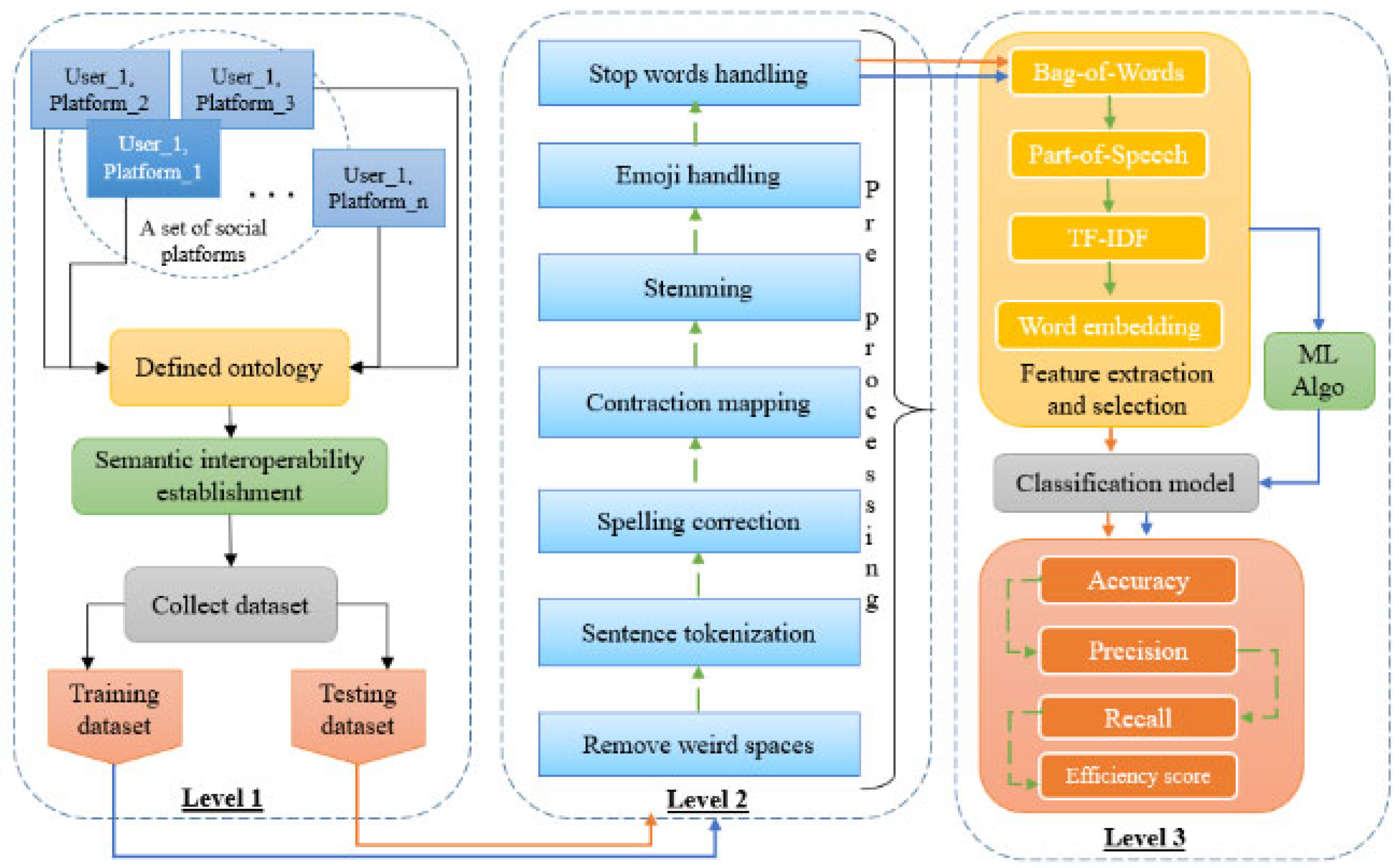

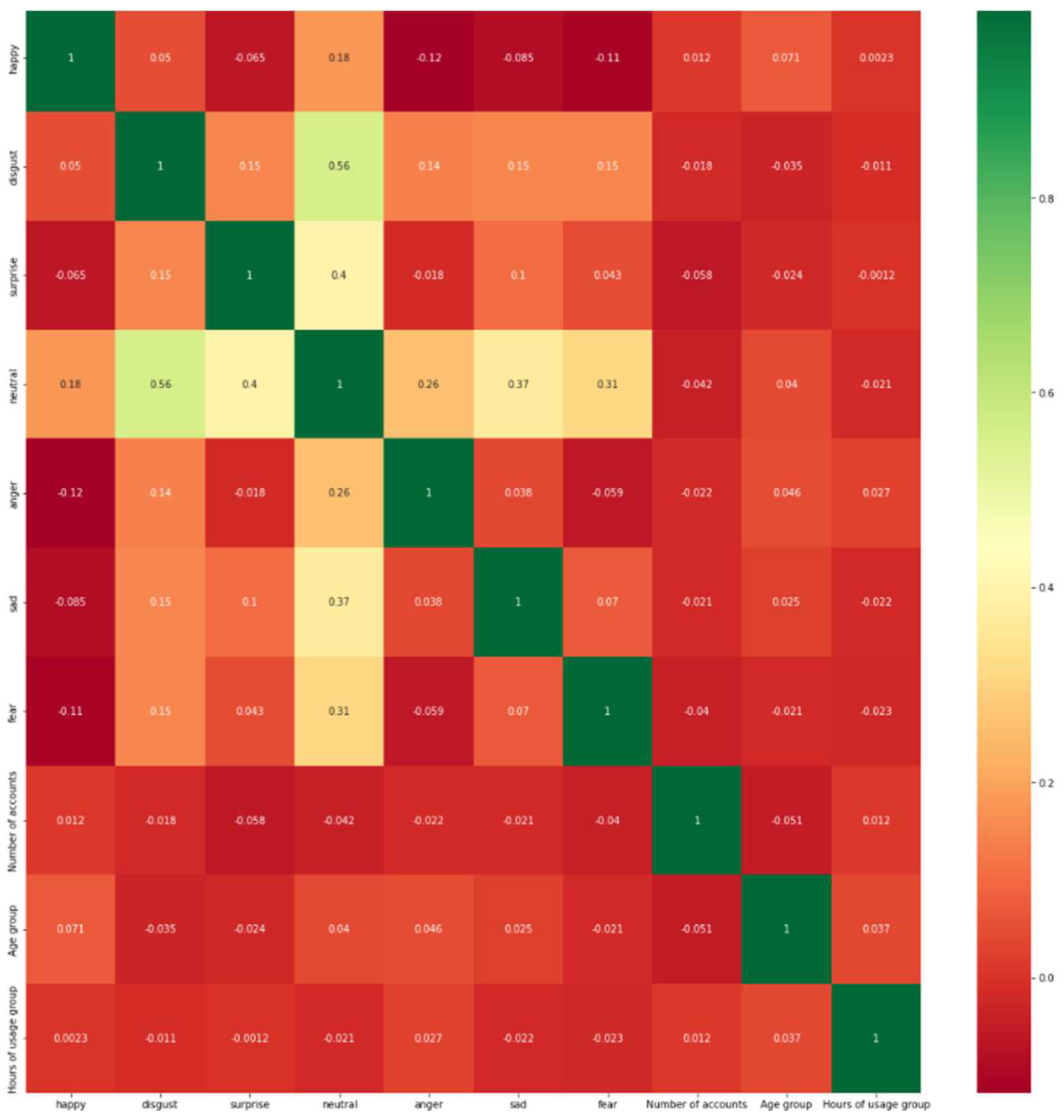
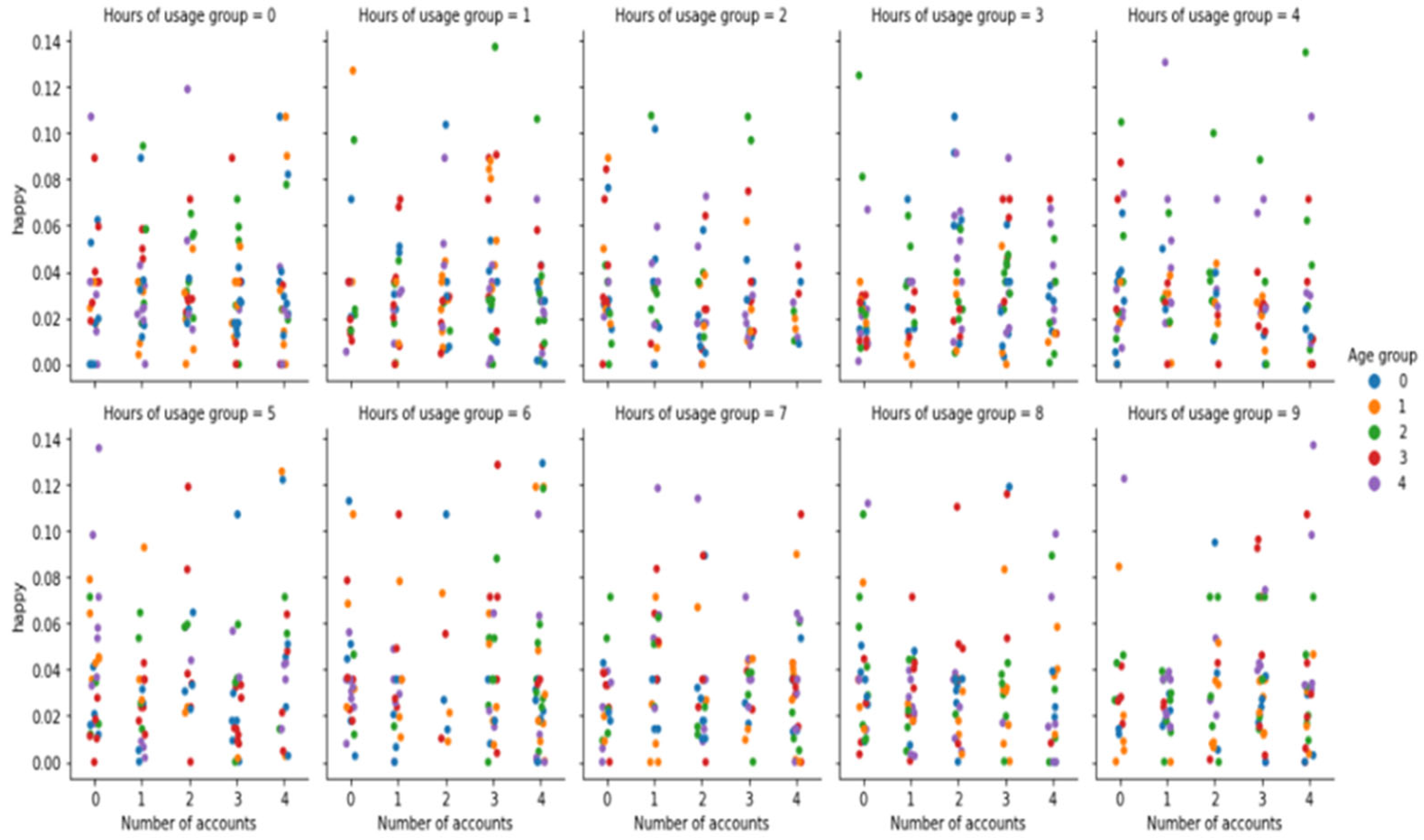
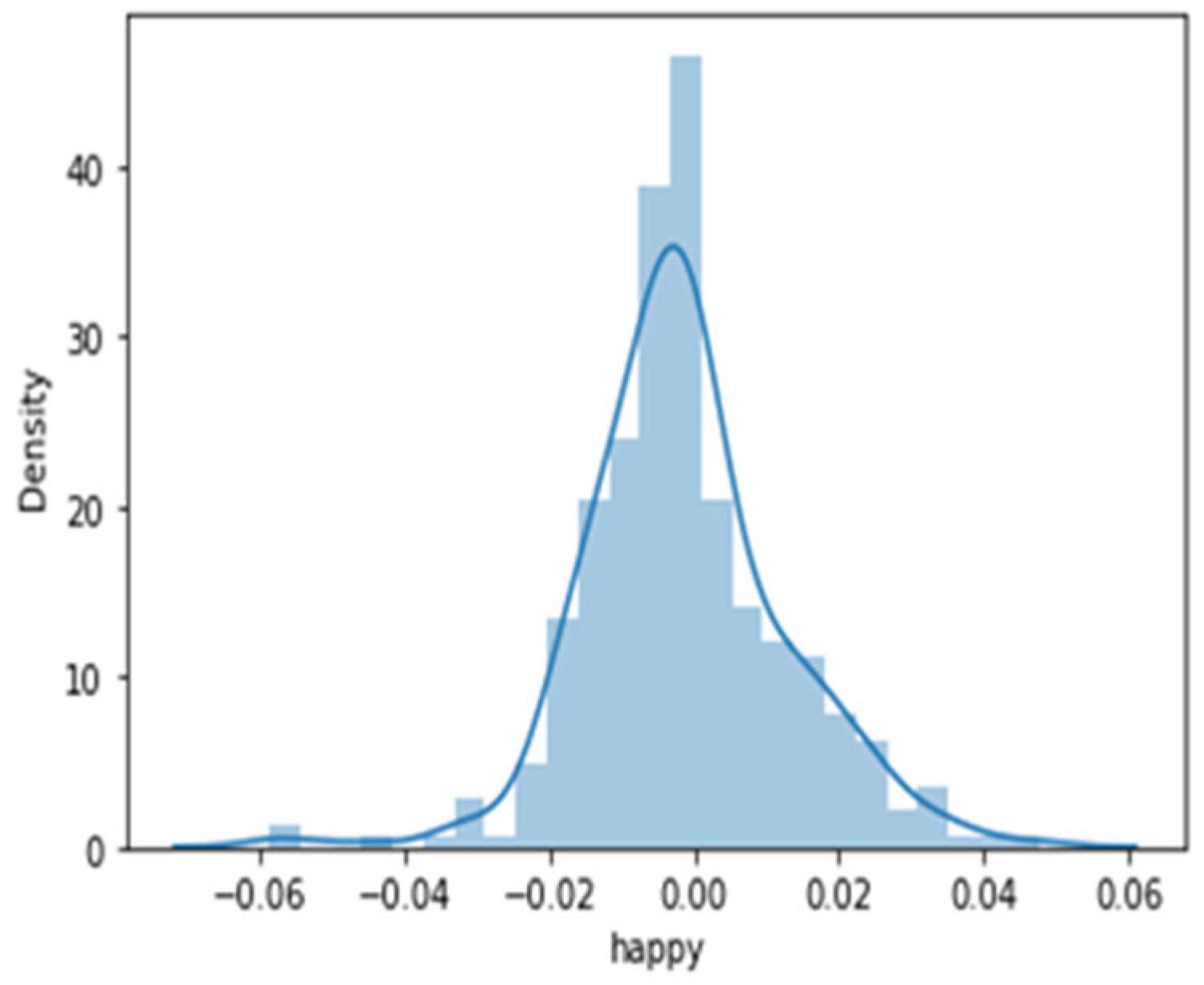
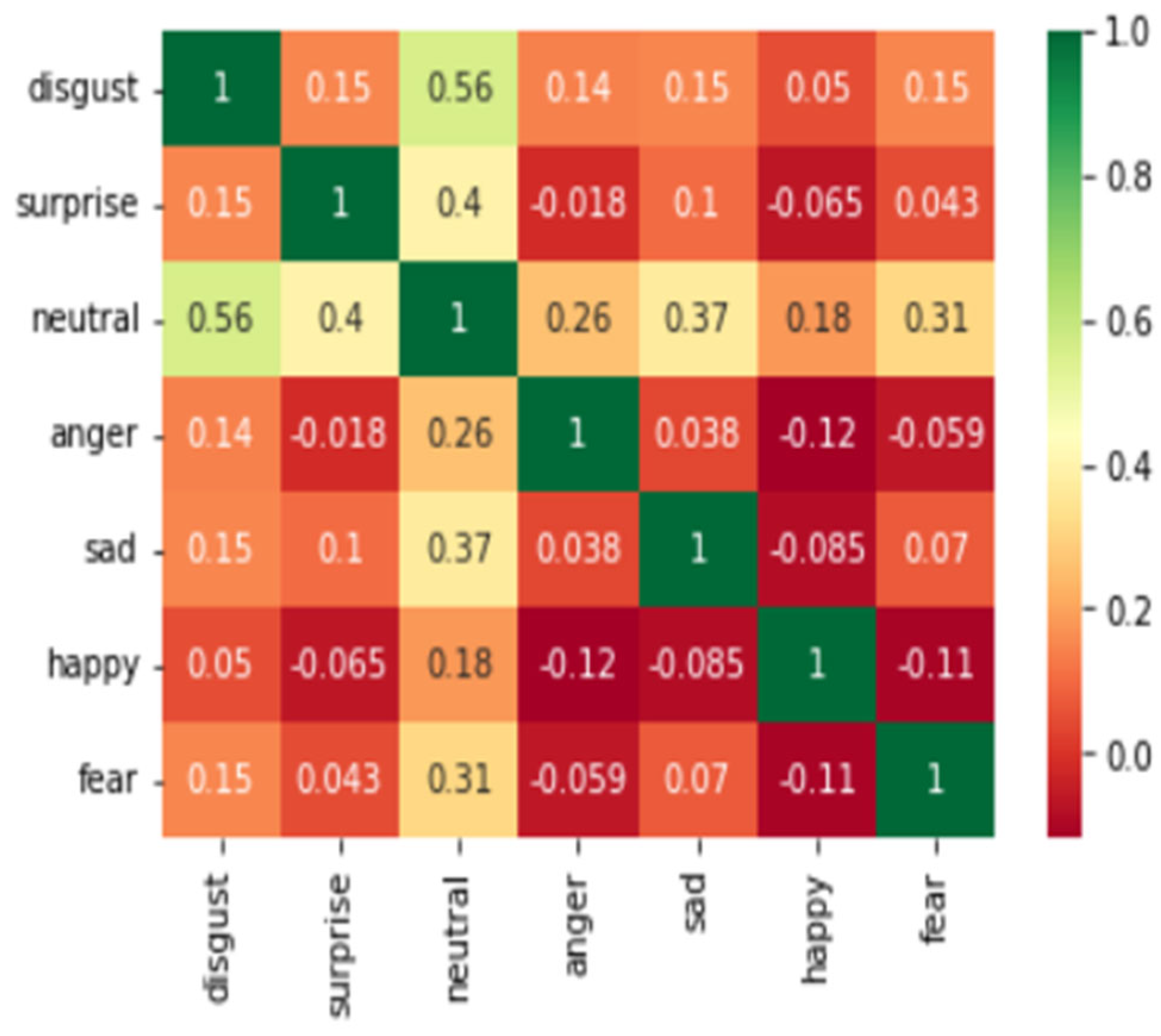
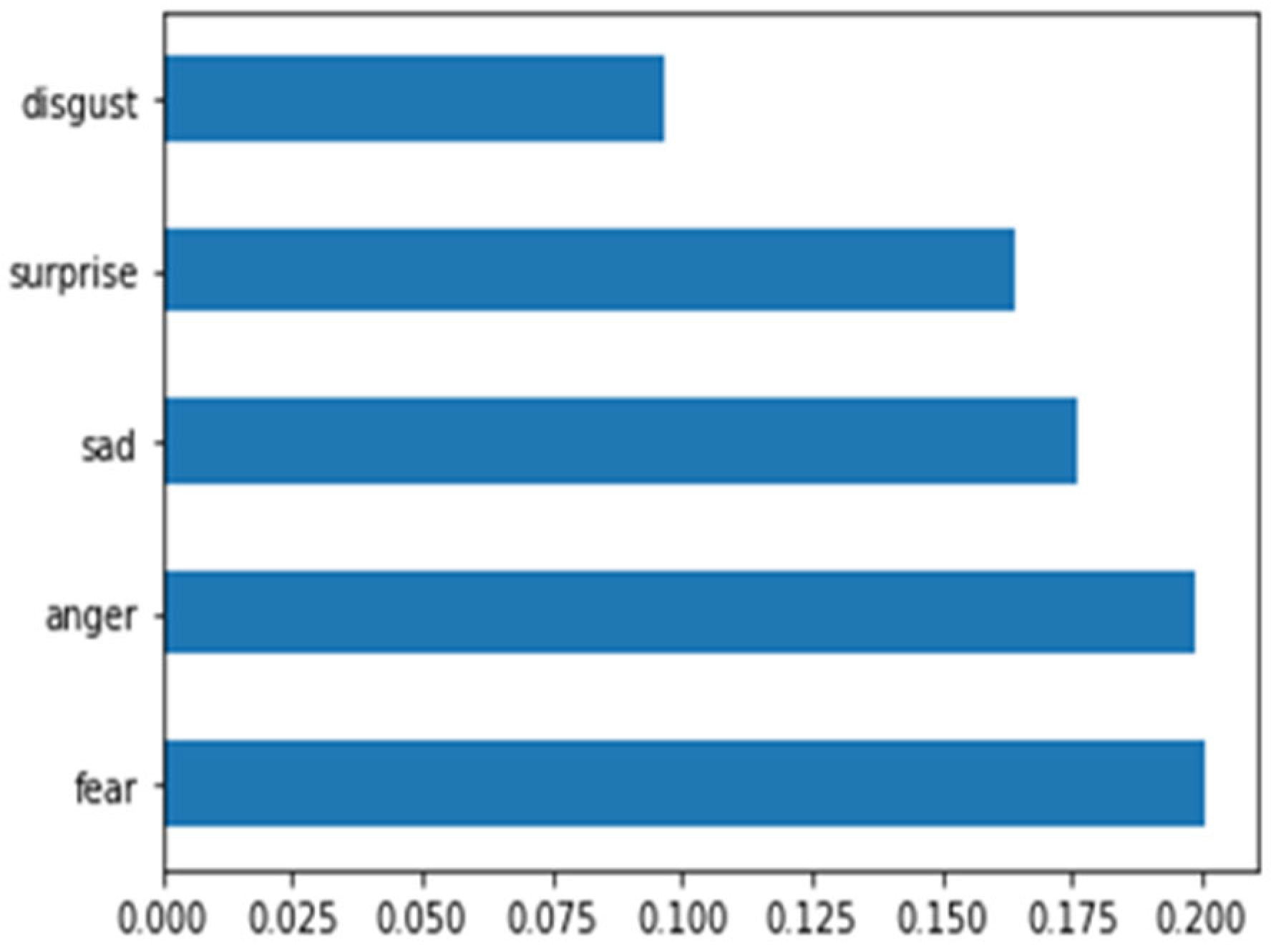

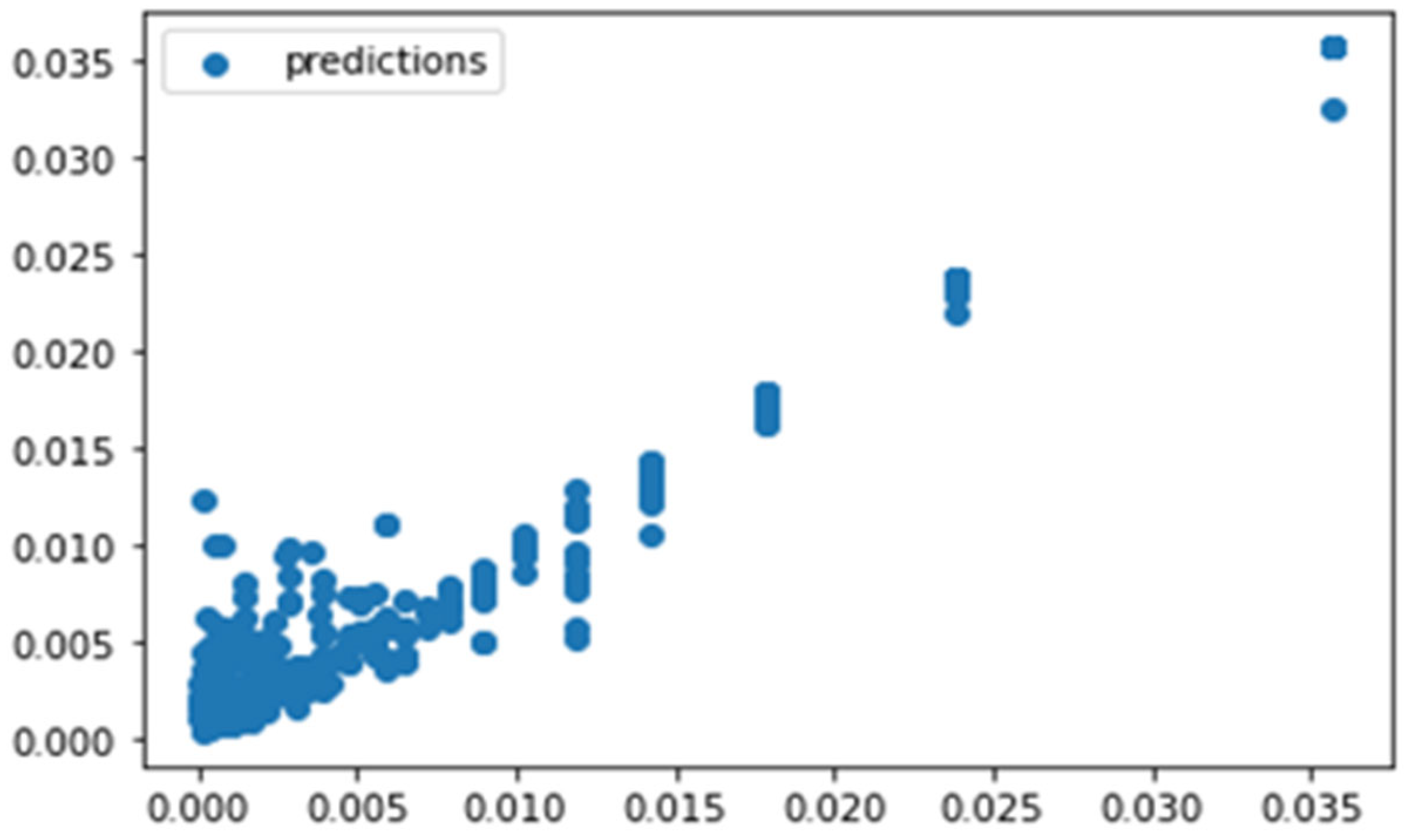
| Value of | Abbreviation Form | Calculated Value |
|---|---|---|
| Mean absolute error | MAE | 0.0015339035 |
| Mean squared error | MSE | 0.0000081479 |
| Root mean squared error on prediction | RMSE | 0.0028544564 |
Disclaimer/Publisher’s Note: The statements, opinions and data contained in all publications are solely those of the individual author(s) and contributor(s) and not of MDPI and/or the editor(s). MDPI and/or the editor(s) disclaim responsibility for any injury to people or property resulting from any ideas, methods, instructions or products referred to in the content. |
© 2023 by the authors. Licensee MDPI, Basel, Switzerland. This article is an open access article distributed under the terms and conditions of the Creative Commons Attribution (CC BY) license (https://creativecommons.org/licenses/by/4.0/).
Share and Cite
Alqahtani, A.; Khan, S.B.; Alqahtani, J.; AlYami, S.; Alfayez, F. Sentiment Analysis of Semantically Interoperable Social Media Platforms Using Computational Intelligence Techniques. Appl. Sci. 2023, 13, 7599. https://doi.org/10.3390/app13137599
Alqahtani A, Khan SB, Alqahtani J, AlYami S, Alfayez F. Sentiment Analysis of Semantically Interoperable Social Media Platforms Using Computational Intelligence Techniques. Applied Sciences. 2023; 13(13):7599. https://doi.org/10.3390/app13137599
Chicago/Turabian StyleAlqahtani, Ali, Surbhi Bhatia Khan, Jarallah Alqahtani, Sultan AlYami, and Fayez Alfayez. 2023. "Sentiment Analysis of Semantically Interoperable Social Media Platforms Using Computational Intelligence Techniques" Applied Sciences 13, no. 13: 7599. https://doi.org/10.3390/app13137599
APA StyleAlqahtani, A., Khan, S. B., Alqahtani, J., AlYami, S., & Alfayez, F. (2023). Sentiment Analysis of Semantically Interoperable Social Media Platforms Using Computational Intelligence Techniques. Applied Sciences, 13(13), 7599. https://doi.org/10.3390/app13137599






